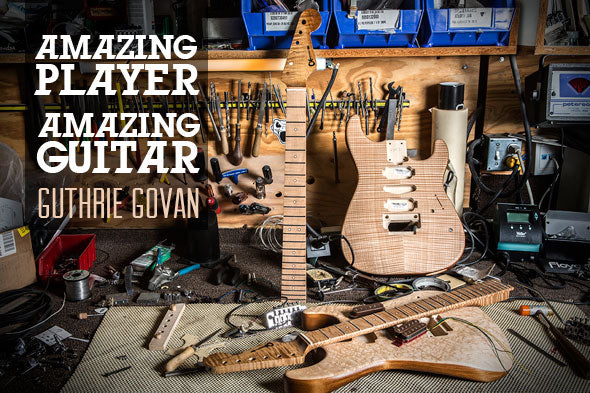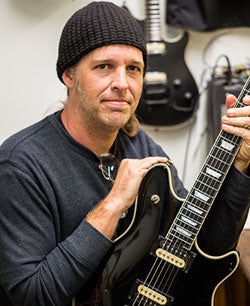Guthrie Govan Signature Charvel Builder’s Diary, Part One

Amazing Player, Amazing Guitar: Part One by Chip Ellis
If you haven’t heard of Guthrie Govan yet, you should probably check him out. He has taken guitar playing to a whole new realm of wizardry and class. I’ll be honest, when I was assigned to this project, I had only heard the name and just assumed I would be working with a clone of Satriani or Vai. I couldn’t have been more wrong. I started listening to his solo work and his Aristocrats project and was blown away. Then I started checking out his instructional videos on YouTube and was equally blown away by his manner of explaining his technique. This guy is the real deal with a healthy dose of humility and class. Sure, he can melt your face with speed, but he doesn’t. He seems to favor the vibe of a piece of work and knowing when to throttle back for integrity. To me, he’s a welcomed counterpoint to the speed demons that have graced the covers of guitar magazines for decades.
I was fortunate to have been assigned to work on his new signature model from Charvel with “Red” Dave Nichols (Charvel MasterBuilder), Michael Frank-Braun (Pickup Guru), and Mr. Govan himself. Working directly with a player of Guthrie’s caliber is always a welcome learning experience for me. We all have our ideas on what the ultimate guitar would be, but hearing what an accomplished player has in mind for his/her needs often contradicts what someone like myself would envision. It forces you look at design through someone else’s eyes and jump on board. The end result is a guitar I never would have thought up on my own, but have to acquire one for myself. It is quite simply the best guitar ever produced by Charvel.
Throughout the prototyping process, Guthrie was open minded and willing to experiment. He doesn’t point out issues and leave it to us to figure out. Instead, he has a charming way of framing issues as improvements worth pursuing and is very concise with his feedback. Any time we delivered a new proto to him, he would immediately put it through a few gigs and send us a very detailed account of what works and what we can do to make it work better. He takes the time to ask audience members after the show what they liked and didn’t like about the latest proto’s tone. He wants to make sure this guitar not only works for him, but the consumer as well.
Now, on to the guitar. There’s a lot to it so let’s start with the neck.
We started simple with a wide array of options available to us as far as wood choice and shape. What we ended up with is far from simple and absolutely beautiful. We are using “baked” flame maple. What we call baked is a wood curing technique that cooks the maple in an oxygen-free oven to stabilize the wood. It makes the wood harder and less susceptible to changing climates – very important to touring musicians. This process also makes the wood more uniform in regards to tone as well. From my experience, I have yet to play a baked neck with any dead spots. Ask the Zoo guys, they’ve been hip to this stuff for a few years now!
 Another change in the maple that occurs in the baking process is the color of the wood – it darkens as if it’s been submerged in Jack Daniels for the last decade. Because of the color of the wood and lack of finish, black or clay fret dots would wash out under certain colors of stage lighting. The fix we landed on was natural maple dots banded in a ring of ebony. It’s a nice aesthetic that adds a needed contrast for different stage lighting.
Another change in the maple that occurs in the baking process is the color of the wood – it darkens as if it’s been submerged in Jack Daniels for the last decade. Because of the color of the wood and lack of finish, black or clay fret dots would wash out under certain colors of stage lighting. The fix we landed on was natural maple dots banded in a ring of ebony. It’s a nice aesthetic that adds a needed contrast for different stage lighting.
Stability was a major factor in the design of this neck. To enhance the stability of the baked maple, we opted for a 2-way truss rod and reinforced the neck with graphite rods that parallel the truss rod. This combination gave us a neck that easily adjust straight as an arrow and the need to adjust happens much less frequently. It’s stiff and doesn’t flex much during rapid changes in string tension, as in heavy trem arm usage.
The stainless steel jumbo fretwire fits the theme of this guitar as well. Stabile and reliable. I love this stuff! When properly dressed, the frets play flawlessly for years with virtually no wear. When you have no fret wear, you won’t find yourself raising your string action to compensate for a low or high fret. You can set it up to your liking and keep that setup dialed for years because of all of these features working together. Plus, you have the classic Charvel neck shape with rolled edges and compound radius that is the legacy of brand. This neck feels, plays, and performs like no other. You may think I’m biased, but play one for yourself. I would be surprised if you disagree.
I’ll get into the body and electronics in my next installment. Stay tuned – there’s a lot going on under the hood!
 Chip Ellis is a supremely talented Fender Masterbuilder and principal engineer for the EVH line of guitars. His skills, taste, and relentless attention to detail have earned him admiration from guitarists like Guthrie Govan and Eddie Van Halen. The Govan Charvel is one of our favorite and most anticipated guitars here at The Music Zoo, and we’re proud to have his exclusive series of posts from Chip detailing the process.
Chip Ellis is a supremely talented Fender Masterbuilder and principal engineer for the EVH line of guitars. His skills, taste, and relentless attention to detail have earned him admiration from guitarists like Guthrie Govan and Eddie Van Halen. The Govan Charvel is one of our favorite and most anticipated guitars here at The Music Zoo, and we’re proud to have his exclusive series of posts from Chip detailing the process.





